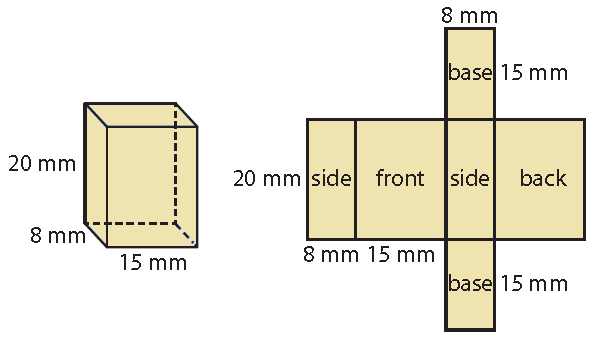MODELING SURFACE AREA OF A PRISM
Subscribe to our ▶️ YouTube channel 🔴 for the latest videos, updates, and tips.
The surface area of a three-dimensional figure is the sum of the areas of all its surfaces. You know how to use the net of a figure to find its surface area. Now you will discover a formula that you can use.

A. The lateral area L of a prism is the area of all faces except the bases.
L = 2(160 mm2) + 2(300 mm2) = 920 mm2
B. The area B of each base is 120 mm2.
C. The total area of the bases is sum of the areas of two bases (top and bottom).
That is,
= 120 mm2 + 120 mm2 = 240 mm2
D. The surface area S of the prism is the sum of the lateral area L and the total area of the bases,
That is,
= 920 mm2 + 240 mm2
= 1160 mm2
Reflect
1. Analyze Relationships Use the net above to answer this question :
How does the product of the perimeter P of the base of the prism and the height h of the prism compare to the lateral area L ?
Ph = L
2. Critical Thinking How can you express the surface area S of the prism in terms of P, h, and B? Use your answer to Question 1.
S = Ph + 2B
Subscribe to our ▶️ YouTube channel 🔴 for the latest videos, updates, and tips.
Kindly mail your feedback to v4formath@gmail.com
We always appreciate your feedback.
©All rights reserved. onlinemath4all.com
Recent Articles
-
SAT Math Practice
Dec 05, 25 04:04 AM
SAT Math Practice - Different Topics - Concept - Formulas - Example problems with step by step explanation -
10 Hard SAT Math Questions (Part - 37)
Dec 03, 25 07:02 AM
10 Hard SAT Math Questions (Part - 37) -
Factorial Problems and Solutions
Dec 02, 25 09:27 AM
Factorial Problems and Solutions

